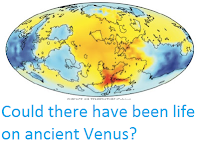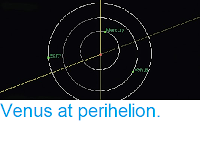The planet Venus will reach apihelion (the furthest point on its orbit
to the Sun) at 2.43 pm GMT on Friday 10 July 2020, when it will be 0.73 AU (109 206 000 km) from the Sun. This is only 0.01 AU (1 496 000) more
distant than the planet's periphelion (closest point on its
orbit from the
Sun), as Venus has the least eccentric circular orbit of any planet in
our Solar
System, this is about 1% the distance between
the Earth and the Sun.
The relative positions of Mars, Earth, Venus and Mercury on 10 July 2020. From the point of view of an Earth based observer the Venusian
perihelion will make no difference to the planets visibility. JPL Small Body Database Browser.
Because Venus is closer to the Sun than the Earth, its year is somewhat
shorter, only 224.7 Earth days compared to 365.25 for the Earth, and
Venus's last aphelion fell on 28 November 2019. Despite a Venusian Year
having passed since this date, the planet has not yet completed a full
day, as a Venusian day is actually longer than its year, at 243 Earth
days, with Venus rotating clockwise on its axis while orbiting the Sun
anti-clockwise. Exactly why this occurs is uncertain, as all other
planets both orbit and rotate in an anti-clockwise direction; it is
uncertain whether the planet has reached this situation by slow
evolution of its orbit over billions of years from an unstable condition
within the original protoplanetary disk from which all the planets
formed, or whether its modern orbit results from an encounter with some
other body at some point in the past. Either way Venus is unique in that
(were it possible to see the sky from the planet's surface) the Sun
would appear to pass across the sky from west to east, and that the time
it took to complete a circuit from the perspective of a viewer on the
surface would be significantly from the length of the planet's 'day'.
This is because the shorter Venusian year affects the movement of the
Sun across the sky more than the longer day, so that it is possible to
talk about a 'Solar Day' on Venus (the length of time it takes a feature
on the planet's surface to pass from directly under the Sun round to
back directly under the Sun), only 116.75 days.
See also...
Follow Sciency Thoughts on Facebook.





